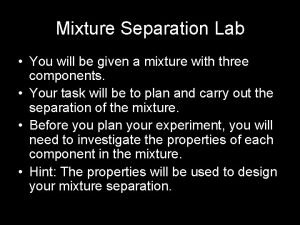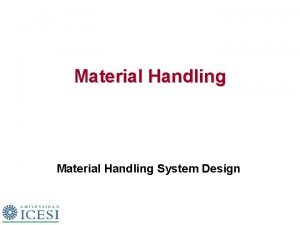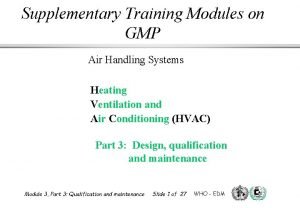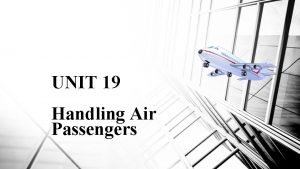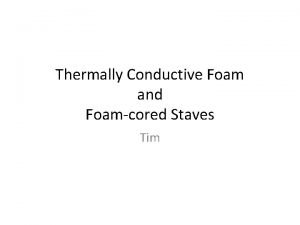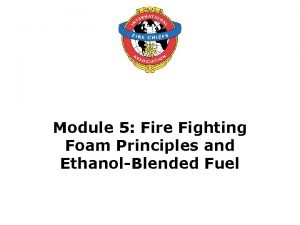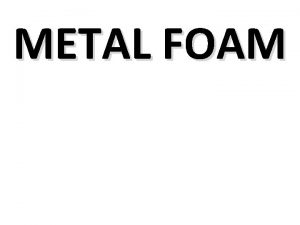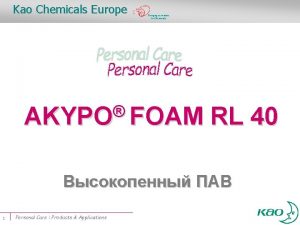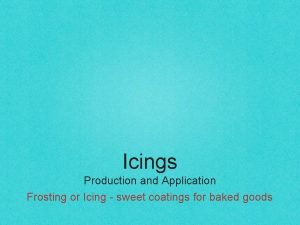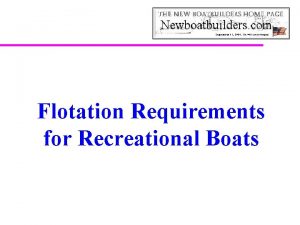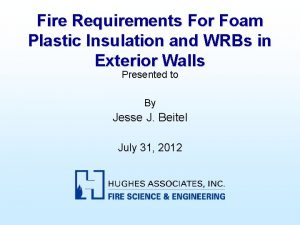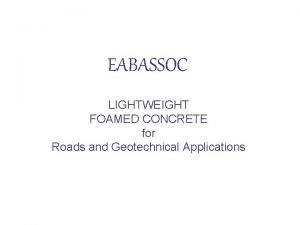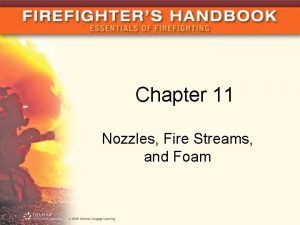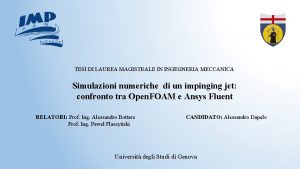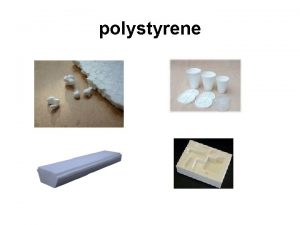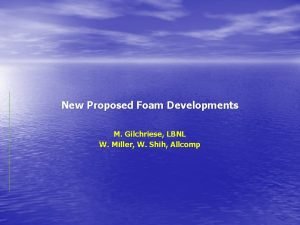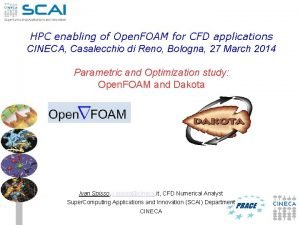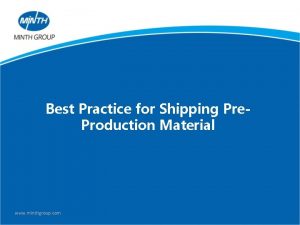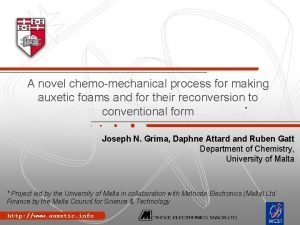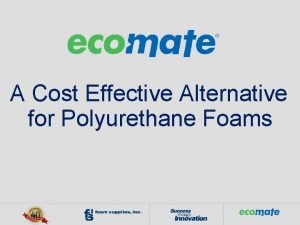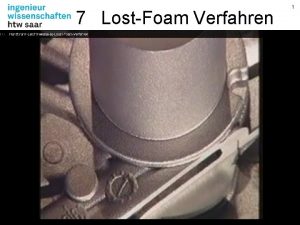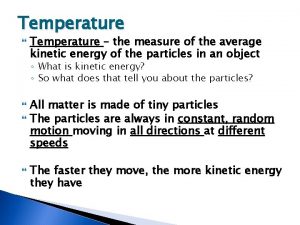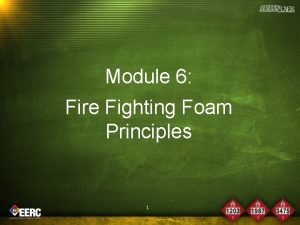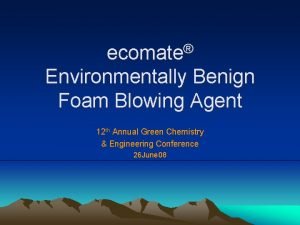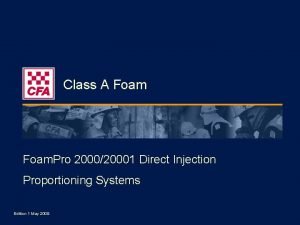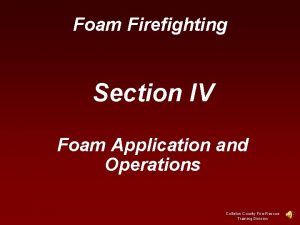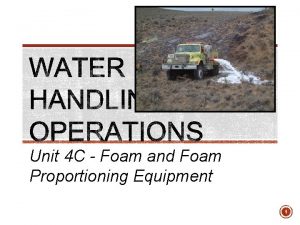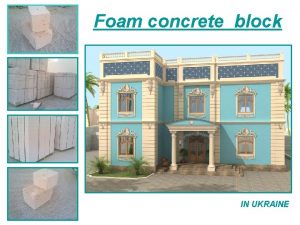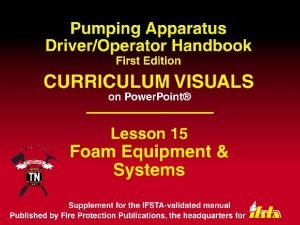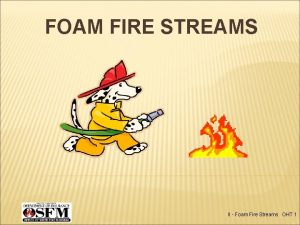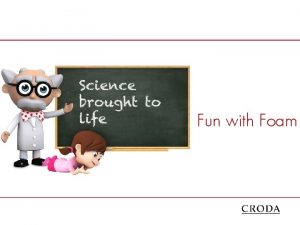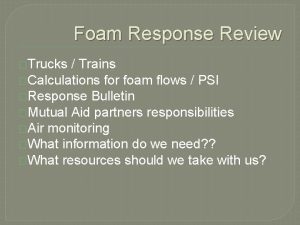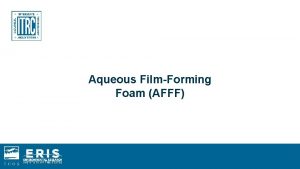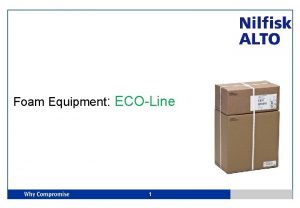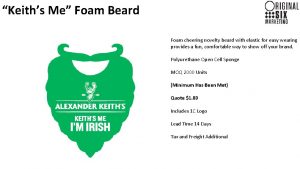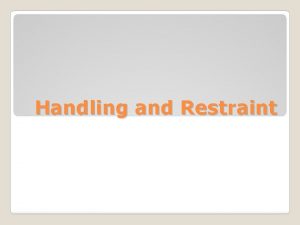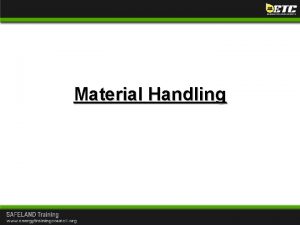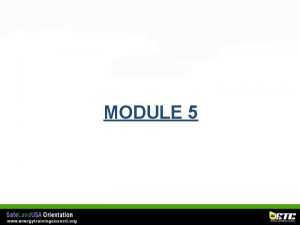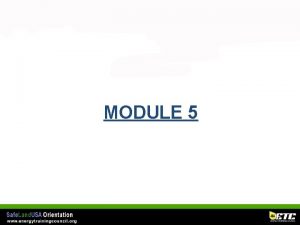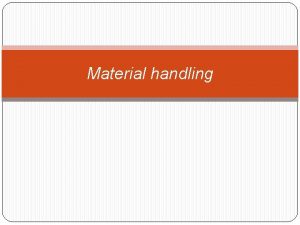Water Handling Operations Unit 4 C Foam and





































- Slides: 37

Water Handling Operations Unit 4 C - Foam and Foam Proportioning Equipment 4 C-1

Objectives • Discuss why foam is more effective than plain water when performing wildland fire suppression operations. • Discuss foam safety including guidelines for handling foam products. • Identify and discuss the advantages and disadvantages of two manual foam proportioning methods used when performing wildland fire suppression operations. 4 C-2

Objectives • Identify various operational components of the Foam Pro 1600/1601. • Demonstrate the ability to set up, run, have foam solution pumped to a nozzle person, and shut down a foam proportioner. 4 C-3

4 C-4

4 C-5

4 C-6

4 C-7

4 C-8

4 C-9

4 C-10

4 C-11

4 C-12

Foam Proportioners 4 C-13

Manual Foam Proportioners • Operators manually adjust the device to maintain a constant mix ratio when water flow and pressure changes. – Cannot maintain constant mix ratio over various flow and pressure rates 4 C-14

Batch Mixing 4 C-15

Suction Side Foam Proportioners 4 C-16

4 C-17

Automatic Foam Proportioner • The automatic foam proportioner makes an adjustment on its own to maintain a constant mix ratio when water flow and pressure changes. 4 C-18

Foam Pro 1601 Electronic Direct Injection Foam Proportioner s 4 C-19

Foam Pro 1601 • Proportional and automatic • No loss of pressure or flow • Works on discharge side of pump • Accurate at all flow ranges • Class A foam only • Resupply foam without interruption • Requires water flow and electrical current • No restrictions due to hose length or number of nozzles 4 C-20

Robwen Flow Mix Balanced Pressure Bladder Foam Proportioner Three-way Valve Pressure Tank with Bladder Concentrate Fill Line Water Dump Line Foam Concentrate Metering Valve Check Valve Water Pump Modified Venturi/ Pressure Differential Valve 4 C-21

Robwen Flow Mix Portable Unit 4 C-22

Robwen Flow Mix Fixed Mount 4 C-23

Robwen Flow Mix • Proportional and automatic • Some loss of pressure or flow • Works on discharge side of pump • Accurate at all flow ranges • Uses Class A or B foam • Cannot resupply foam without interruption • Requires only water flow to operate • No restrictions do to hose length or number of nozzles 4 C-24

Operating the Foam Pro 1601 (Major Components) • Operator control module • Motor driver box/module • Paddlewheel flowmeter • Foam pump and electric motor • Calibrate/Inject valve • Inline strainer 4 C-25

Operator Control Module (Panel Mounted) • Operating instructions • On/Off switch • Injection rate control – Adjustable from 0. 1%-1. 0% • Low concentrate (“LOW CONC. ”) light 4 C-26

Motor Driver Box/Module (Normal Operation) Simulated flow switch “Down” for normal operation Circuit breaker switch “Up” for normal operation 4 C-27

Paddlewheel Flowmeter 4 C-28

Foam Pump and Electric Motor 4 C-29

Calibrate/Inject Valve 4 C-30

Purging Air • Enter “Simulated Flow” – Switch to “Up” position – Preprogrammed for 100 gpm • Valve to “Cal/Flush” • Turn panel switch “On” • Run pump until concentrate flows from dump line 4 C-31

Purging Air (Continued) • Turn control panel to “Off” position • Return valve to “Inject” • Exit “Simulated Flow” by returning switch to “Down” position 4 C-32

Inline Strainer 4 C-33

Foam Injection Check Valve and Injection Port 4 C-34

Objectives • Discuss why foam is more effective than plain water when performing wildland fire suppression operations. • Discuss foam safety including guidelines for handling foam products. • Identify and discuss the advantages and disadvantages of two manual foam proportioning methods used when performing wildland fire suppression operations. 4 C-35

Objectives • Identify various operational components of the Foam Pro 1600/1601. • Demonstrate the ability to set up, run, have foam solution pumped to a nozzle person, and shut down a foam proportioner. 4 C-36

Vehicle Fire Case Study 4 C-37
 Water and water and water water
Water and water and water water Unit 11 water water everywhere
Unit 11 water water everywhere How to separate sand and finely ground polystyrene foam
How to separate sand and finely ground polystyrene foam Material handling design
Material handling design Air handling unit system
Air handling unit system Unit 19 handling air passengers
Unit 19 handling air passengers Unit 10, unit 10 review tests, unit 10 general test
Unit 10, unit 10 review tests, unit 10 general test Unit 20 hospitality operations in travel and tourism
Unit 20 hospitality operations in travel and tourism Tungsten foam
Tungsten foam Pocofoam
Pocofoam Foam tetrahedron
Foam tetrahedron Metal foam advantages
Metal foam advantages Akypo soft 100 bvc
Akypo soft 100 bvc Foam type icing
Foam type icing Foampro fire fighting
Foampro fire fighting Boat flotation foam requirements
Boat flotation foam requirements Foam plastic insulation
Foam plastic insulation Eabassoc
Eabassoc Piercing nozzles fire fighting
Piercing nozzles fire fighting Open foam corso
Open foam corso Canoe key pass egret
Canoe key pass egret Eps foam pro
Eps foam pro Foam cells definition
Foam cells definition Compressed rvc foam
Compressed rvc foam Cfd applications
Cfd applications Muffin termasuk dalam golongan foam type cake
Muffin termasuk dalam golongan foam type cake Foam sutida
Foam sutida Auxetic materials
Auxetic materials Pu foam making formula
Pu foam making formula Modelltraube
Modelltraube Yamuna river foam
Yamuna river foam Heat is a measure of the average kinetic
Heat is a measure of the average kinetic Cutinova foam
Cutinova foam Foam suppression system
Foam suppression system Ecomate blowing agent
Ecomate blowing agent Foampro 2001
Foampro 2001 Foam rolling contraindications
Foam rolling contraindications Flexderm
Flexderm


